

Jordan’s capital city manages to mingle heritage with the here and now. Roman ruins, lively markets and beloved mosques exist alongside art galleries, modern rooftop restaurants, cooking schools and cooperatives. All of it makes the city a great place for exploring. Here are 10 of the top attractions in Amman for your next trip.
Citadel Hill
Relics of Jordan’s ancient past still stand atop Jabal al-Qala’a (Citadel Hill), at the center of the city. Walk or drive up to the historic site for a chance to wander among ruins that include Umayyad Palace (believed to have been built around A.D. 720) and the Roman-style Temple of Hercules. From this vantage point, you can also get 360-degree views of the cityscape.
Al Balad
The main street of old downtown, Al Balad is a fun place to shop, snack and people-watch. When stepping into the steady stream of pedestrians on this road — flanked by fruit and vegetable markets, cafés, Arab eateries, spice shops and souvenir stores — you will flow with the heartbeat of the city.
You also can visit another historic site nearby: the Roman Theater, on the far end of Al Balad. Originally constructed in the 2nd century, this restored theater still plays host to concerts and events.
Souk al Juma’a
Rub elbows with residents at Souk al Juma’a, the Friday market. Vendors sell a wide variety of products from their makeshift stalls, including kitchenware, shoes and clothing imported from Europe. Come with some cash and a sense of adventure — there’s plenty of quality goods at low prices if you’re in the mood for treasure hunting through the hangars.
Located at Ras al-Ain near Second Circle, the market sets up late every Thursday evening and stays open through Friday afternoon.
Beit Sitti
Spend some time in the kitchen with local chefs at Beit Sitti, meaning “Grandmother’s House.” This cook-and-dine experience was born from three sisters’ desire to carry on their grandma’s legacy through Arab cuisine and culture. Cooking lessons take place in a historic villa in Al Weibdeh and meals are enjoyed on the terrace when the weather allows. Beit Sitti can be booked privately or individuals may join scheduled group lessons.

Al Abdali
This developing area of Amman, sometimes referred to as the “new downtown,” has become a popular spot for shopping and dining. You’ll find The Boulevard — premium shops lining a pedestrian strip, rooftop lounges and modern hotels, including W Amman — steps from important religious structures such as the King Abdullah I Mosque (also called the “blue mosque” for its turquoise-colored mosaic dome).
Arts and culture
Fuel your mind and feed your soul with arts and cultural events around the city. Browse Arab art in galleries such as Darat Al Funun, Dar Al-Anda and The National Gallery of Fine Arts. Discover urban art in the streets, alleys and stairways of Al Weibdeh. Sign up for a jewelry-making workshop at the Design Institute in Jabal Amman. Catch a local or foreign film at the legendary Rainbow Theatre. Or share a meal and engage in meaningful cross-cultural conversations at a Shams Community or Jadal event.
Rainbow Street
One of the oldest streets in Amman, this is also one of the few walkable areas. Spend an evening visiting galleries, smoking shisha or sipping tea in a café, and feasting on Jordanian fare. New restaurants constantly pop up, so the best way to find out which ones are open is to take a stroll and see for yourself. One staple is Al Quds. Its falafel sandwich is a must — even the king of Jordan approves (he posted his visit on social media).
Rainbow Street is generally quiet during the day and comes alive in the evening, particularly on Thursdays. If you’re here on a Friday in the summertime (June through September), check out Souk Jara, a pop-up handicrafts market.

Kunafeh and other treats
You can’t visit Amman without sampling some local sweets. Kunafeh — a piping-hot dessert made of pastry and cheese, drizzled with syrup and sprinkled with pistachios — is a must. The legendary Habibah is the place for it, so if you’ve only got time to taste kunafeh once, it should be here.
You also can find kunafeh at many other restaurants in town, such as the Bedouin-inspired, upscale setting at Nasim in Fairmont Amman. While at Nasim, indulge in another popular Jordanian dessert, umm Ali, a baked pastry pudding served fresh from the oven.
If you’re wandering Rainbow Street, stop by Sufra, where the menu features kunafeh alongside awameh (small spheres of fried dough drenched in syrup or honey), lokum (also known as Turkish delight, typically made of a gelatin with chopped dates, hazelnuts, pistachios and walnuts, and then flavored with rosewater, lemon or bergamot orange) and aish el saraya (a bread pudding with cream and pistachios).
Coffee and tea are often served after dinner, so they are available at most restaurants. If you’re in Jabal Amman, try a shai bil nana (tea with mint) or Turkish coffee prepared in a traditional way — in hot sand — at Ayman Coffee near Second Circle.

Sunset views
A city built on hills provides plenty of sunset viewpoints. If you’re already at the Citadel in the late afternoon, stick around for sundown. Or reserve a table at one of the city’s rooftop terraces — Cantaloupe Gastro Pub, Ghoroub, Wild Jordan and Four Seasons Hotel Amman offer a few of the many options.
Iraq al-Amir
Come for the cliffside caves and ancient palace ruins and stay for the homecooked meal and warm hospitality. Iraq al-Amir (meaning “Caves of Princes”) gets its name from the Copper Age caves here. Just 10 miles from the center of Amman, it’s close enough to make a day trip yet far enough to escape the city crowds. Qasr al-Abd, the pre-Roman palace, is particularly stunning at sunset.
There’s no need to go home hungry. Arrange a meal at Iraq Al-Amir Women’s Cooperative and then shop the handcrafted ceramics and woven items in its onsite store while the group prepares a traditional spread using locally sourced ingredients. Hands-on workshops and overnight stays in the guesthouse are also available with advance notice.
